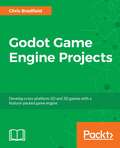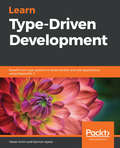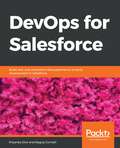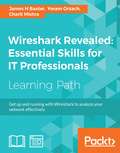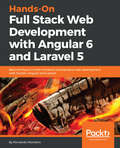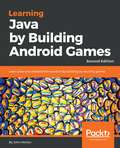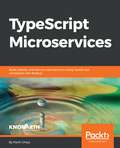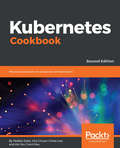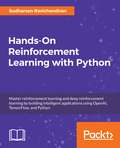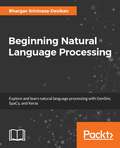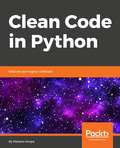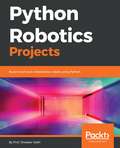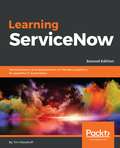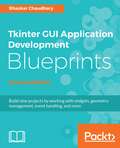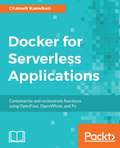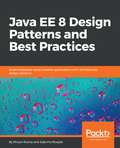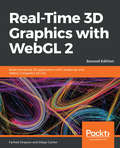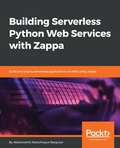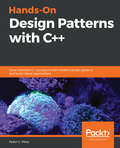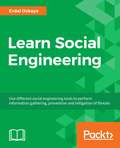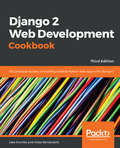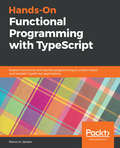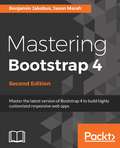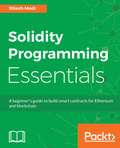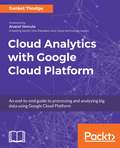- Table View
- List View
Godot Engine Game Development Projects: Build five cross-platform 2D and 3D games with Godot 3.0
by Chris BradfieldA project based guides to learn animation, advanced shaders, environments, particle rendering, and networked games with Godot 3.0Key FeaturesLearn the art of developing cross-platform gamesLeverage Godot’s node and scene system to design robust, reusable game objectsIntegrate Blender easily and efficiently with Godot to create powerful 3D gamesBook DescriptionGodot Engine Game Development Projects is an introduction to the Godot game engine and its new 3.0 version. Godot 3.0 brings a large number of new features and capabilities that make it a strong alternative to expensive commercial game engines. For beginners, Godot offers a friendly way to learn game development techniques, while for experienced developers it is a powerful, customizable tool that can bring your visions to life.This book consists of five projects that will help developers achieve a sound understanding of the engine when it comes to building games.Game development is complex and involves a wide spectrum of knowledge and skills. This book can help you build on your foundation level skills by showing you how to create a number of small-scale game projects. Along the way, you will learn how Godot works and discover important game development techniques that you can apply to your projects.Using a straightforward, step-by-step approach and practical examples, the book will take you from the absolute basics through to sophisticated game physics, animations, and other techniques. Upon completing the final project, you will have a strong foundation for future success with Godot 3.0.What you will learnGet started with the Godot game engine and editorOrganize a game projectImport graphical and audio assetsUse Godot’s node and scene system to design robust, reusable game objectsWrite code in GDScript to capture input and build complex behaviorsImplement user interfaces to display informationCreate visual effects to spice up your gameLearn techniques that you can apply to your own game projectsWho this book is forGodot Engine Game Development Projects is for both new users and experienced developers, who want to learn to make games using a modern game engine. Some prior programming experience in C and C++ is recommended.
Learn Type Driven Development: Benefit from type systems to build reliable and safe applications using ReasonML 3
by Yawar AminProgrammers coming from dynamically-typed languages who have felt the pain of production bugs and are looking for ways to mitigate them, and programmers from statically-typed languages looking for more safety and performance techniques, and possibly for a better experience with a statically-typed language.
DevOps for Salesforce: Build, test, and streamline data pipelines to simplify development in Salesforce
by Priyanka Dive Nagraj GornalliImplement DevOps for Salesforce and explore its featuresKey FeaturesLearn DevOps principles and techniques for enterprise operations in SalesforceImplement Continuous Integration and Continuous Delivery using tools such as Jenkins and Ant scriptUse the Force.com Migration Tool and Git to achieve versioning in SalesforceBook DescriptionSalesforce is one of the top CRM tools used these days, and with its immense functionalities and features, it eases the functioning of an enterprise in various areas of sales, marketing, and finance, among others. Deploying Salesforce applications is a tricky event, and it can get quite taxing for admins and consultants. This book addresses all the problems that you might encounter while trying to deploy your applications and shows you how to resort to DevOps to take these challenges head on.Beginning with an overview of the development and delivery process of a Salesforce app, DevOps for Salesforce covers various types of sandboxing and helps you understand when to choose which type. You will then see how different it is to deploy with Salesforce as compared to deploying with another app. You will learn how to leverage a migration tool and automate deployment using the latest and most popular tools in the ecosystem. This book explores topics such as version control and DevOps techniques such as Continuous Integration, Continuous Delivery, and testing. Finally, the book will conclude by showing you how to track bugs in your application changes using monitoring tools and how to quantify your productivity and ROI.By the end of the book, you will have acquired skills to create, test, and effectively deploy your applications by leveraging the features of DevOps.What you will learnImplement DevOps for Salesforce and understand the benefits it offersAbstract the features of Force.com MigrationTool to migrate and retrieve metadataDevelop your own CI/CD Pipeline for Salesforce projectUse Qualitia to perform scriptless automation for Continuous TestingTrack application changes using BugzillaApply Salesforce best practices to implement DevOpsWho this book is forIf you are a Salesforce developer, consultant, or manager who wants to learn DevOps tools and set up pipelines for small as well as large Salesforce projects, this book is for you.
Wireshark Revealed: Essential Skills for IT Professionals
by James H Baxter Yoram Orzach Charit MishraMaster Wireshark and discover how to analyze network packets and protocols effectively, along with engaging recipes to troubleshoot network problems About This Book • Gain valuable insights into the network and application protocols, and the key fields in each protocol • Use Wireshark's powerful statistical tools to analyze your network and leverage its expert system to pinpoint network problems • Master Wireshark and train it as your network sniffer Who This Book Is For This book is aimed at IT professionals who want to develop or enhance their packet analysis skills. A basic familiarity with common network and application services terms and technologies is assumed. What You Will Learn • Discover how packet analysts view networks and the role of protocols at the packet level • Capture and isolate all the right packets to perform a thorough analysis using Wireshark's extensive capture and display filtering capabilities • Decrypt encrypted wireless traffic • Use Wireshark as a diagnostic tool and also for network security analysis to keep track of malware • Find and resolve problems due to bandwidth, throughput, and packet loss • Identify and locate faults in communication applications including HTTP, FTP, mail, and various other applications – Microsoft OS problems, databases, voice, and video over IP • Identify and locate faults in detecting security failures and security breaches in the network In Detail This Learning Path starts off installing Wireshark, before gradually taking you through your first packet capture, identifying and filtering out just the packets of interest, and saving them to a new file for later analysis. You will then discover different ways to create and use capture and display filters. By halfway through the book, you'll be mastering Wireshark features, analyzing different layers of the network protocol, and looking for any anomalies.We then start Ethernet and LAN switching, through IP, and then move on to TCP/UDP with a focus on TCP performance problems. It also focuses on WLAN security. Then, we go through application behavior issues including HTTP, mail, DNS, and other common protocols. This book finishes with a look at network forensics and how to locate security problems that might harm the network.This course provides you with highly practical content explaining Metasploit from the following books: 1) Wireshark Essentials 2) Network Analysis Using Wireshark Cookbook 3) Mastering Wireshark Style and approach This step-by-step guide follows a practical approach, starting from the basic to the advanced aspects. Through a series of real-world examples, this learning path will focus on making it easy for you to become an expert at using Wireshark.
Hands-On Full Stack Web Development with Angular 6 and Laravel 5: Become fluent in both frontend and backend web development with Docker, Angular and Laravel
by Fernando MonteiroBuild modern, fast, and progressive web applications using modern features of PHP 7 and TypeScriptKey FeaturesExplore the latest features of Angular and Laravel to build applications that are powerful, consistent, and maintainableDevelop modern user interfaces with a reusable component-based architecture using Angular 6 and Bootstrap 4Learn how to build secure backend APIs with LaravelBook DescriptionAngular, considered as one of the most popular and powerful frontend frameworks, has undergone a major overhaul to embrace emerging web technologies so that developers can build cutting-edge web applications.This book gives you practical knowledge of building modern full-stack web apps from scratch using Angular with a Laravel Restful back end.The book begins with a thorough introduction to Laravel and Angular and its core concepts like custom errors messages, components, routers, and Angular-cli, with each concept being explained first, and then put into practice in the case-study project.With the basics covered, you will learn how sophisticated UI features can be added using NgBootstrao and a component-based architecture. You will learn to extend and customize variables from Bootstrap CSS framework.You will learn how to create secure web application with Angular and Laravel using token based authentication. Finally, you will learn all about progressive web applications and build and deploy a complete fullstack application using Docker and Docker-compose.By the end of this book, you'll gain a solid understanding of Angular 6 and how it interacts with a Laravel 5.x backendWhat you will learnExplore the core features of Angular 6 to create sophisticated user interfacesUse Laravel 5 to its full extent to create a versatile backend layer based on RESTful APIsConfigure a web application in order to accept user-defined data and persist it into the database using server-side APIsBuild an off-line-first application using service-worker and manifest fileDeal with token based authentication on single page application (SPA).Secure your application against threats and vulnerabilities in a time efficient wayDeploy using Docker and Docker-composeWho this book is forThis book targets developers who are new to Angular, Laravel, or both, and are seeking a practical, best-practice approach to development with these technologies. They must have some knowledge of HTML, CSS and JavaScript. Familiarity of PHP is assumed to get the most from this book.
Learning Java by Building Android Games: Learn Java and Android from scratch by building six exciting games, 2nd Edition
by John HortonGet ready for a fun-filled experience of learning Java by developing games for the Android platformKey FeaturesLearn Java, Android, and object-oriented programming from scratchBuild games including Sub Hunter, Retro Pong, Bullet Hell, Classic Snake, and a 2D Scrolling ShooterCreate and design your own games, such as an open-world platform gameBook DescriptionAndroid is one of the most popular mobile operating systems presently. It uses the most popular programming language, Java, as the primary language for building apps of all types. However, this book is unlike other Android books in that it doesn’t assume that you already have Java proficiency.This new and expanded second edition of Learning Java by Building Android Games shows you how to start building Android games from scratch. The difficulty level will grow steadily as you explore key Java topics, such as variables, loops, methods, object oriented programming, and design patterns, including code and examples that are written for Java 9 and Android P. At each stage, you will put what you’ve learned into practice by developing a game. You will build games such as Minesweeper, Retro Pong, Bullet Hell, and Classic Snake and Scrolling Shooter games. In the later chapters, you will create a time-trial, open-world platform game. By the end of the book, you will not only have grasped Java and Android but will also have developed six cool games for the Android platform.What you will learnSet up a game development environment in Android StudioImplement screen locking, screen rotation, pixel graphics, and play sound effectsRespond to a player’s touch, and program intelligent enemies who challenge the player in different waysLearn game development concepts, such as collision detection, animating sprite sheets, simple tracking and following, AI, parallax backgrounds, and particle explosionsAnimate objects at 60 frames per second (FPS) and manage multiple independent objects using Object-Oriented Programming (OOP)Understand the essentials of game programming, such as design patterns, object-oriented programming, Singleton, strategy, and entity-component patternsLearn how to use the Android API, including Activity lifecycle, detecting version number, SoundPool API, Paint, Canvas, and Bitmap classes Build a side-scrolling shooter and an open world 2D platformer using advanced OOP concepts and programming patternsWho this book is forLearning Java by Building Android Games is for you if you are completely new to Java, Android, or game programming and want to make Android games. This book also acts as a refresher for those who already have experience of using Java on Android or any other platform without game development experience.
TypeScript Microservices: Build, deploy, and secure Microservices using TypeScript combined with Node.js
by Parth GhiyaBuild robust microservice-based applications that are distributed, fault tolerant, and always availableKey FeaturesLearn to build message-driven services for effective communicationDesign microservices API using Reactive programming design patternsDeploy, scale and monitor microservices for consistent high performanceBook DescriptionIn the last few years or so, microservices have achieved the rock star status and right now are one of the most tangible solutions in enterprises to make quick, effective, and scalable applications. The apparent rise of Typescript and long evolution from ES5 to ES6 has seen lots of big companies move to ES6 stack. If you want to learn how to leverage the power of microservices to build robust architecture using reactive programming and Typescript in Node.js, then this book is for you.Typescript Microservices is an end-to-end guide that shows you the implementation of microservices from scratch; right from starting the project to hardening and securing your services. We will begin with a brief introduction to microservices before learning to break your monolith applications into microservices. From here, you will learn reactive programming patterns and how to build APIs for microservices. The next set of topics will take you through the microservice architecture with TypeScript and communication between services. Further, you will learn to test and deploy your TypeScript microservices using the latest tools and implement continuous integration. Finally, you will learn to secure and harden your microservice.By the end of the book, you will be able to build production-ready, scalable, and maintainable microservices using Node.js and Typescript.What you will learnGet acquainted with the fundamentals behind microservices.Explore the behavioral changes needed for moving from monolithic to microservices.Dive into reactive programming, Typescript and Node.js to learn its fundamentals in microservicesUnderstand and design a service gateway and service registry for your microservices.Maintain the state of microservice and handle dependencies.Perfect your microservice with unit testing and Integration testingDevelop a microservice, secure it, deploy it, and then scale itWho this book is forThis book is for JavaScript developers seeking to utilize their Node.js and Typescript skills to build microservices and move away from the monolithic architecture. Prior knowledge of TypeScript and Node.js is assumed.
Kubernetes Cookbook: Practical solutions to container orchestration, 2nd Edition
by Hui-Chuan Chloe Lee Ke-Jou Carol Hsu Hideto SaitoLearn how to automate and manage your containers and reduce the overall operation burden on your system.Key FeaturesUse containers to manage, scale and orchestrate apps in your organizationTransform the latest concept of Kubernetes 1.10 into examplesExpert techniques for orchestrating containers effectivelyBook DescriptionKubernetes is an open source orchestration platform to manage containers in a cluster environment. With Kubernetes, you can configure and deploy containerized applications easily. This book gives you a quick brush up on how Kubernetes works with containers, and an overview of main Kubernetes concepts, such as Pods, Deployments, Services and etc. This book explains how to create Kubernetes clusters and run applications with proper authentication and authorization configurations. With real-world recipes, you'll learn how to create high availability Kubernetes clusters on AWS, GCP and in on-premise datacenters with proper logging and monitoring setup. You'll also learn some useful tips about how to build a continuous delivery pipeline for your application. Upon completion of this book, you will be able to use Kubernetes in production and will have a better understanding of how to manage containers using Kubernetes.What you will learnBuild your own container clusterDeploy and manage highly scalable, containerized applications with KubernetesBuild high-availability Kubernetes clustersBuild a continuous delivery pipeline for your applicationTrack metrics and logs for every container running in your clusterStreamline the way you deploy and manage your applications with large-scale container orchestrationWho this book is forThis book is for system administrators, developers, DevOps engineers, or any stakeholder who wants to understand how Kubernetes works using a recipe-based approach. Basic knowledge of Kubernetes and Containers is required.
Hands-On Reinforcement Learning with Python: Master reinforcement and deep reinforcement learning using OpenAI Gym and TensorFlow
by Sudharsan RavichandiranA hands-on guide enriched with examples to master deep reinforcement learning algorithms with PythonKey FeaturesYour entry point into the world of artificial intelligence using the power of PythonAn example-rich guide to master various RL and DRL algorithmsExplore various state-of-the-art architectures along with mathBook DescriptionReinforcement Learning (RL) is the trending and most promising branch of artificial intelligence. Hands-On Reinforcement learning with Python will help you master not only the basic reinforcement learning algorithms but also the advanced deep reinforcement learning algorithms.The book starts with an introduction to Reinforcement Learning followed by OpenAI Gym, and TensorFlow. You will then explore various RL algorithms and concepts, such as Markov Decision Process, Monte Carlo methods, and dynamic programming, including value and policy iteration. This example-rich guide will introduce you to deep reinforcement learning algorithms, such as Dueling DQN, DRQN, A3C, PPO, and TRPO. You will also learn about imagination-augmented agents, learning from human preference, DQfD, HER, and many more of the recent advancements in reinforcement learning.By the end of the book, you will have all the knowledge and experience needed to implement reinforcement learning and deep reinforcement learning in your projects, and you will be all set to enter the world of artificial intelligence.What you will learnUnderstand the basics of reinforcement learning methods, algorithms, and elementsTrain an agent to walk using OpenAI Gym and TensorflowUnderstand the Markov Decision Process, Bellman’s optimality, and TD learningSolve multi-armed-bandit problems using various algorithmsMaster deep learning algorithms, such as RNN, LSTM, and CNN with applicationsBuild intelligent agents using the DRQN algorithm to play the Doom gameTeach agents to play the Lunar Lander game using DDPGTrain an agent to win a car racing game using dueling DQNWho this book is forIf you’re a machine learning developer or deep learning enthusiast interested in artificial intelligence and want to learn about reinforcement learning from scratch, this book is for you. Some knowledge of linear algebra, calculus, and the Python programming language will help you understand the concepts covered in this book.
Natural Language Processing and Computational Linguistics: A practical guide to text analysis with Python, Gensim, spaCy, and Keras
by Bhargav Srinivasa-DesikanWork with Python and powerful open source tools such as Gensim and spaCy to perform modern text analysis, natural language processing, and computational linguistics algorithms.Key FeaturesDiscover the open source Python text analysis ecosystem, using spaCy, Gensim, scikit-learn, and KerasHands-on text analysis with Python, featuring natural language processing and computational linguistics algorithmsLearn deep learning techniques for text analysisBook DescriptionModern text analysis is now very accessible using Python and open source tools, so discover how you can now perform modern text analysis in this era of textual data.This book shows you how to use natural language processing, and computational linguistics algorithms, to make inferences and gain insights about data you have. These algorithms are based on statistical machine learning and artificial intelligence techniques. The tools to work with these algorithms are available to you right now - with Python, and tools like Gensim and spaCy.You'll start by learning about data cleaning, and then how to perform computational linguistics from first concepts. You're then ready to explore the more sophisticated areas of statistical NLP and deep learning using Python, with realistic language and text samples. You'll learn to tag, parse, and model text using the best tools. You'll gain hands-on knowledge of the best frameworks to use, and you'll know when to choose a tool like Gensim for topic models, and when to work with Keras for deep learning.This book balances theory and practical hands-on examples, so you can learn about and conduct your own natural language processing projects and computational linguistics. You'll discover the rich ecosystem of Python tools you have available to conduct NLP - and enter the interesting world of modern text analysis.What you will learn Why text analysis is important in our modern age Understand NLP terminology and get to know the Python tools and datasetsLearn how to pre-process and clean textual dataConvert textual data into vector space representationsUsing spaCy to process text Train your own NLP models for computational linguisticsUse statistical learning and Topic Modeling algorithms for text, using Gensim and scikit-learnEmploy deep learning techniques for text analysis using KerasWho this book is forThis book is for you if you want to dive in, hands-first, into the interesting world of text analysis and NLP, and you're ready to work with the rich Python ecosystem of tools and datasets waiting for you!
Clean Code in Python: Refactor your legacy code base
by Mariano AnayaGetting the most out of Python to improve your codebaseKey FeaturesSave maintenance costs by learning to fix your legacy codebaseLearn the principles and techniques of refactoringApply microservices to your legacy systems by implementing practical techniquesBook DescriptionPython is currently used in many different areas such as software construction, systems administration, and data processing. In all of these areas, experienced professionals can find examples of inefficiency, problems, and other perils, as a result of bad code. After reading this book, readers will understand these problems, and more importantly, how to correct them. The book begins by describing the basic elements of writing clean code and how it plays an important role in Python programming. You will learn about writing efficient and readable code using the Python standard library and best practices for software design. You will learn to implement the SOLID principles in Python and use decorators to improve your code. The book delves more deeply into object oriented programming in Python and shows you how to use objects with descriptors and generators. It will also show you the design principles of software testing and how to resolve software problems by implementing design patterns in your code. In the final chapter we break down a monolithic application to a microservice one, starting from the code as the basis for a solid platform. By the end of the book, you will be proficient in applying industry approved coding practices to design clean, sustainable and readable Python code. What you will learnSet up tools to effectively work in a development environmentExplore how the magic methods of Python can help us write better codeExamine the traits of Python to create advanced object-oriented designUnderstand removal of duplicated code using decorators and descriptorsEffectively refactor code with the help of unit testsLearn to implement the SOLID principles in PythonWho this book is forThis book will appeal to team leads, software architects and senior software engineers who would like to work on their legacy systems to save cost and improve efficiency. A strong understanding of Programming is assumed.
Python Robotics Projects: Build smart and collaborative robots using Python
by Diwakar VaishLeverage the power of Python to build DIY robotic projectsKey FeaturesDesign, build, and stimulate collaborative robotsBuild high-end robotics projects such as a customized personal JarvisLeverage the power of Python and ROS for DIY robotic projectsBook DescriptionRobotics is a fast-growing industry. Multiple surveys state that investment in the field has increased tenfold in the last 6 years, and is set to become a $100-billion sector by 2020. Robots are prevalent throughout all industries, and they are all set to be a part of our domestic lives. This book starts with the installation and basic steps in configuring a robotic controller. You'll then move on to setting up your environment to use Python with the robotic controller. You'll dive deep into building simple robotic projects, such as a pet-feeding robot, and more complicated projects, such as machine learning enabled home automation system (Jarvis), vision processing based robots and a self-driven robotic vehicle using Python. By the end of this book, you'll know how to build smart robots using Python.What you will learn Get to know the basics of robotics and its functions Walk through interface components with microcontrollers Integrate robotics with the IoT environment Build projects using machine learning Implement path planning and vision processing Interface your robots with BluetoothWho this book is forIf building robots is your dream, then this book is made for you. Prior knowledge of Python would be an added advantage.
Learning ServiceNow: Administration and development on the Now platform, for powerful IT automation, 2nd Edition
by Tim WoodruffIT service management automation at your fingertipsKey FeaturesLearn to leverage ServiceNow’s capabilities for improved IT automation by following step-by-step, practical instructionsBuild core administration, development, and maintenance skills with IT service management in ServiceNowImprove your workflow efficiency by designing and creating responsive and automated workflows, business logic, and front-end automationBook DescriptionThis book is an updated version of Learning ServiceNow, that will cover the new and updated features of the ServiceNow platform. It will show you how to put important ServiceNow features to work in the real world, while introducing key concepts via examples of managing and automating IT services. It'll help you build a solid foundation of knowledge, and will demonstrate how to effectively implement and configure modules within ServiceNow. We'll show you how to configure and administer your instance, and then move on to building strong user interfaces and creating powerful workflows.We also cover other key elements of ServiceNow, such as notifications, security, reporting, and custom development. You will learn how to improve and automate your business' workflow and processes. By the end of this book, you will be able to successfully configure and manage ServiceNow like a pro.What you will learnRead and write clear, effective code for the ServiceNow platformIdentify and avoid common pitfalls and missteps that could seriously impact future progress and upgradeability Use debugging tools to troubleshoot when things go wrongDiscover tips and tricks from top ServiceNow developers, architects, and administrators. Find out what the pros wish they knew when they were starting outWho this book is forThis book is for IT professionals and administrators who are planning to or are already trying to implement ServiceNow in their organization for Enterprise IT service management tasks.Some familiarity with web technologies (JavaScript) would be helpful. Prior ServiceNow experience is not necessary.
Tkinter GUI Application Development Blueprints, Second Edition: Build Nine Projects By Working With Widgets, Geometry Management, Event Handling, And More, 2nd Edition
by Bhaskar ChaudharyTkinter is the built-in GUI package that comes with standard Python distributions. It is a cross-platform package, which means you build once and deploy everywhere. It is simple to use and intuitive in nature, making it suitable for learners. This book will enable you to use Tkinter effectively through working on nine versatile projects.
Docker for Serverless Applications: Containerize and orchestrate functions using OpenFaas, OpenWhisk, and Fn
by Chanwit KaewkasiBuild applications and infrastructures that leverage Function-as-a-Service and DockerKey Features- Implement containerization in Serverless/FaaS environments- Utilize Docker as a functional unit of work for Serverless/FaaS platforms- Use Docker as a portable infrastructure for Serverless ApplicationsBook DescriptionServerless applications have gained a lot of popularity among developers and are currently the buzzwords in the tech market. Docker and serverless are two terms that go hand-in-hand.This book will start by explaining serverless and Function-as-a-Service (FaaS) concepts, and why they are important. Then, it will introduce the concepts of containerization and how Docker fits into the Serverless ideology. It will explore the architectures and components of three major Docker-based FaaS platforms, how to deploy and how to use their CLI. Then, this book will discuss how to set up and operate a production-grade Docker cluster. We will cover all concepts of FaaS frameworks with practical use cases, followed by deploying and orchestrating these serverless systems using Docker. Finally, we will also explore advanced topics and prototypes for FaaS architectures in the last chapter.By the end of this book, you will be in a position to build and deploy your own FaaS platform using Docker.What you will learn Learn what Serverless and FaaS applications are Get acquainted with the architectures of three major serverless systems Explore how Docker technologies can help develop Serverless applications Create and maintain FaaS infrastructures Set up Docker infrastructures to serve as on-premises FaaS infrastructures Define functions for Serverless applications with Docker containersWho this book is forIf you are a Developer, a Docker Engineer, a DevOps Engineer, or any stakeholder interested in learning the use of Docker on Serverless environments then this book is for you.
Java EE 8 Design Patterns and Best Practices: Build enterprise-ready scalable applications with architectural design patterns
by João Purificação Rhuan RochaGet the deep insights you need to master efficient architectural design considerations and solve common design problems in your enterprise applications.Key FeaturesThe benefits and applicability of using different design patterns in JAVA EE Learn best practices to solve common design and architectural challengesChoose the right patterns to improve the efficiency of your programs Book DescriptionPatterns are essential design tools for Java developers. Java EE Design Patterns and Best Practices helps developers attain better code quality and progress to higher levels of architectural creativity by examining the purpose of each available pattern and demonstrating its implementation with various code examples. This book will take you through a number of patterns and their Java EE-specific implementations.In the beginning, you will learn the foundation for, and importance of, design patterns in Java EE, and then will move on to implement various patterns on the presentation tier, business tier, and integration tier. Further, you will explore the patterns involved in Aspect-Oriented Programming (AOP) and take a closer look at reactive patterns. Moving on, you will be introduced to modern architectural patterns involved in composing microservices and cloud-native applications. You will get acquainted with security patterns and operational patterns involved in scaling and monitoring, along with some patterns involved in deployment.By the end of the book, you will be able to efficiently address common problems faced when developing applications and will be comfortable working on scalable and maintainable projects of any size.What you will learnImplement presentation layers, such as the front controller patternUnderstand the business tier and implement the business delegate patternMaster the implementation of AOPGet involved with asynchronous EJB methods and REST servicesInvolve key patterns in the adoption of microservices architectureManage performance and scalability for enterprise-level applicationsWho this book is forJava developers who are comfortable with programming in Java and now want to learn how to implement design patterns to create robust, reusable and easily maintainable apps.
Real-Time 3D Graphics with WebGL 2: Build interactive 3D applications with JavaScript and WebGL 2 (OpenGL ES 3.0), 2nd Edition
by Diego Cantor Farhad GhayourA comprehensive guide with 80+ examples on 3D programming in WebGL 2, covering computer graphics topics such as rendering, 3D math, camera, and moreKey FeaturesCreate visually stunning, high-performance 3D applications for the web with WebGL 2A complete course on 3D computer graphics: rendering, 3D math, lighting, cameras, and moreUnlock a variety of new and advanced features offered in WebGL 2Book DescriptionAs highly interactive applications have become an increasingly important part of the user experience, WebGL is a unique and cutting-edge technology that brings hardware-accelerated 3D graphics to the web. Packed with 80+ examples, this book guides readers through the landscape of real-time computer graphics using WebGL 2. Each chapter covers foundational concepts in 3D graphics programming with various implementations. Topics are always associated with exercises for a hands-on approach to learning.This book presents a clear roadmap to learning real-time 3D computer graphics with WebGL 2. Each chapter starts with a summary of the learning goals for the chapter, followed by a detailed description of each topic. The book offers example-rich, up-to-date introductions to a wide range of essential 3D computer graphics topics, including rendering, colors, textures, transformations, framebuffers, lights, surfaces, blending, geometry construction, advanced techniques, and more. With each chapter, you will "level up" your 3D graphics programming skills. This book will become your trustworthy companion in developing highly interactive 3D web applications with WebGL and JavaScript.What you will learnUnderstand the rendering pipeline provided in WebGLBuild and render 3D objects with WebGLDevelop lights using shaders, 3D math, and the physics of light reflectionCreate a camera and use it to navigate a 3D sceneUse texturing, lighting, and shading techniques to render realistic 3D scenesImplement object selection and interaction in a 3D sceneCover advanced techniques for creating immersive and compelling scenesLearn new and advanced features offered in WebGL 2Who this book is forThis book is intended for developers who are interested in building highly interactive 3D applications for the web. A basic understanding of JavaScript is necessary; no prior computer graphics or WebGL knowledge is required.
Building Serverless Python Web Services with Zappa: Build and deploy serverless applications on AWS using Zappa
by Abdulwahid Abdulhaque BarguzarMaster serverless architectures in Python and their implementation, with Zappa on three different frameworks.Key Features Scalable serverless Python web services using Django, Flask, and Pyramid. Learn Asynchronous task execution on AWS Lambda and scheduling using Zappa. Implementing Zappa in a Docker container.Book DescriptionServerless applications are becoming very popular these days, not just because they save developers the trouble of managing the servers, but also because they provide several other benefits such as cutting heavy costs and improving the overall performance of the application.This book will help you build serverless applications in a quick and efficient way. We begin with an introduction to AWS and the API gateway, the environment for serverless development, and Zappa. We then look at building, testing, and deploying apps in AWS with three different frameworks--Flask, Django, and Pyramid. Setting up a custom domain along with SSL certificates and configuring them with Zappa is also covered. A few advanced Zappa settings are also covered along with securing Zappa with AWS VPC.By the end of the book you will have mastered using three frameworks to build robust and cost-efficient serverless apps in Python.What you will learnBuild, test, and deploy a simple web service using AWS CLIIntegrate Flask-based Python applications, via AWS CLI configurationDesign Rest APIs integrated with Zappa for Flask and DjangoCreate a project in the Pyramid framework and configure it with ZappaGenerate SSL Certificates using Amazon Certificate ManagerConfigure custom domains with AWS Route 53Create a Docker container similar to AWS LambdaWho this book is forPython Developers who are interested in learning how to develop fast and highly scalable serverless applications in Python, will find this book useful
Hands-On Design Patterns with C++: Solve common C++ problems with modern design patterns and build robust applications
by Fedor G PikusC++ developers who are comfortable in programming in C++ and now want to learn how to implement design patterns to create robust, reusable and easily maintainable apps.
Learn Social Engineering: Learn the art of human hacking with an internationally renowned expert
by Erdal OzkayaImprove information security by learning Social Engineering.Key FeaturesLearn to implement information security using social engineeringGet hands-on experience of using different tools such as Kali Linux, the Social Engineering toolkit and so onPractical approach towards learning social engineering, for IT securityBook DescriptionThis book will provide you with a holistic understanding of social engineering. It will help you to avoid and combat social engineering attacks by giving you a detailed insight into how a social engineer operates.Learn Social Engineering starts by giving you a grounding in the different types of social engineering attacks,and the damages they cause. It then sets up the lab environment to use different toolS and then perform social engineering steps such as information gathering. The book covers topics from baiting, phishing, and spear phishing, to pretexting and scareware.By the end of the book, you will be in a position to protect yourself andyour systems from social engineering threats and attacks.All in all, the book covers social engineering from A to Z , along with excerpts from many world wide known security experts.What you will learnLearn to implement information security using social engineeringLearn social engineering for IT securityUnderstand the role of social media in social engineeringGet acquainted with Practical Human hacking skillsLearn to think like a social engineerLearn to beat a social engineerWho this book is forThis book targets security professionals, security analysts, penetration testers, or any stakeholder working with information security who wants to learn how to use social engineering techniques. Prior knowledge of Kali Linux is an added advantage
Django 2 Web Development Cookbook: 100 practical recipes on building scalable Python web apps with Django 2, 3rd Edition
by Aidas Bendoraitis Jake KronikaCreate unbelievably fast, robust and secure web apps with Django Web Framework and Python 3.8Key FeaturesDiscover solutions to a variety of web application scenarios, leveraging the power of the Django frameworkUnderstand URL routing, models, forms, templates, and RESTful services with Django 2.14Test, deploy, and scale your web applications efficiently with Amazon Web ServicesBook DescriptionDjango is a framework designed to balance rapid web development with high performance. It handles high levels of user traffic and interaction, integrates with a variety of databases, and collects and processes data in real time. This book follows a task-based approach to guide you through developing with the Django 2.1 framework, starting with setting up and configuring Docker containers and a virtual environment for your project.You'll learn how to write reusable pieces of code for your models and manage database changes. You'll work with forms and views to enter and list data, applying practical examples using templates and JavaScript together for the optimum user experience. This cookbook helps you to adjust the built-in Django administration to fit your needs and sharpen security and performance to make your web applications as robust, scalable, and dependable as possible. You'll also explore integration with Django CMS, the popular content management suite.In the final chapters, you'll learn programming and debugging tricks and discover how collecting data from different sources and providing it to others in various formats can be a breeze. By the end of the book, you'll learn how to test and deploy projects to a remote dedicated server and scale your application to meet user demands.What you will learnGet started with the basic configuration necessary to start any Django projectBuild a database structure out of reusable model mixinsSecure web applications against malicious usage and address common performance bottlenecksIntegrate with, and extend, the Django CMSConstruct and manage complex and deep hierarchiesImport data from local sources and external web services and export it to third partiesWho this book is forThis book is designed for Python developers working on fast and secure web apps that can scale over time. You’ll also find this book useful if you want to upgrade to latest Django framework. A background in Python 3 along with basic knowledge of the Django framework will be useful.
Hands-On Functional Programming with Typescript: Explore functional and reactive programming to create robust and testable TypeScript applications
by Remo H. JansenThis book is designed for readers without previous experience in functional programming with JavaScript, TypeScript or any other programming language. The reader must have some previous experience with TypeScript and web development. No previous knowledge about functional programming is required.
Mastering Bootstrap 4 - Second Edition: Master the latest version of Bootstrap 4 to build highly customized responsive web apps, 2nd Edition
by Benjamin JakobusBuild responsive, dynamic, and mobile-first applications on the web with Bootstrap 4 Key Features Master the art of creating highly intuitive and responsive web interfaces with Bootstrap 4 Combine the power of Bootstrap and popular front-end JavaScript frameworks such as Angular and React to build cutting-edge web apps Infuse your web pages with life and movement using Bootstrap jQuery plugins Book Description Bootstrap 4 is a free CSS and JavaScript framework that allows developers to rapidly build responsive web interfaces. This book will help you use and adapt Bootstrap to produce enticing websites that fit your needs. You will build a customized Bootstrap website from scratch, using various approaches to customize the framework with increasing levels of skill. You will get to grips with Bootstrap's key features and quickly discover various ways in which Bootstrap can help you develop web interfaces. Then take a walk through the fundamental features, such as its grid system, global styles, helper classes, and responsive utilities. When you have mastered these, you will discover how to structure page layouts, utilize Bootstrap's various navigation components, use forms, and style different types of content. Among other things, you will also tour the anatomy of a Bootstrap plugin, create your own custom components, and extend Bootstrap using jQuery. You will also understand what utility classes Bootstrap 4 has to offer, and how you can use them effectively to speed up the development of your website. Finally, you will discover how to optimize your website and integrate it with third-party frameworks. By the end of this book, you will have a thorough knowledge of the framework's ins and outs, and will be able to build highly customizable and optimized web interfaces. What you will learn Create a professional Bootstrap-based website from scratch without using third-party templates Leverage Bootstrap's powerful grid system Style various types of content and learn how to build a page's layout from scratch by applying the power of Bootstrap 4 Take advantage of Bootstrap's form helper and contextual classes Improve your website's overall user experience with headers and footers Infuse your web pages using Bootstrap jQuery plugins and create your own Bootstrap plugins Learn what utility classes Bootstrap 4 has to offer, how they are implemented, and the best way to use them. Create more advanced web interfaces by leveraging the power of accordions, dropdowns, and list groups. Incorporate Bootstrap into an AngularJS or React application and use Bootstrap components as AngularJS directivesWho this book is for This book targets readers who wish to leverage Bootstrap 4 to create responsive web applications. Basic knowledge of web development concepts and web technologies such as HTML, CSS, and JavaScript is required.
Solidity Programming Essentials: A beginner's guide to build smart contracts for Ethereum and blockchain
by Ritesh ModiLearn the most powerful and primary programming language for writing smart contracts and find out how to write, deploy, and test smart contracts in Ethereum.Key FeaturesGet you up and running with Solidity Programming language Build Ethereum Smart Contracts with Solidity as your scripting language Learn to test and deploy the smart contract to your private Blockchain Book DescriptionSolidity is a contract-oriented language whose syntax is highly influenced by JavaScript, and is designed to compile code for the Ethereum Virtual Machine. Solidity Programming Essentials will be your guide to understanding Solidity programming to build smart contracts for Ethereum and blockchain from ground-up.We begin with a brief run-through of blockchain, Ethereum, and their most important concepts or components. You will learn how to install all the necessary tools to write, test, and debug Solidity contracts on Ethereum. Then, you will explore the layout of a Solidity source file and work with the different data types. The next set of recipes will help you work with operators, control structures, and data structures while building your smart contracts. We take you through function calls, return types, function modifers, and recipes in object-oriented programming with Solidity. Learn all you can on event logging and exception handling, as well as testing and debugging smart contracts.By the end of this book, you will be able to write, deploy, and test smart contracts in Ethereum. This book will bring forth the essence of writing contracts using Solidity and also help you develop Solidity skills in no time.What you will learnLearn the basics and foundational concepts of Solidity and Ethereum Explore the Solidity language and its uniqueness in depthCreate new accounts and submit transactions to blockchainGet to know the complete language in detail to write smart contractsLearn about major tools to develop and deploy smart contractsWrite defensive code using exception handling and error checkingUnderstand Truffle basics and the debugging processWho this book is forThis book is for anyone who would like to get started with Solidity Programming for developing an Ethereum smart contract. No prior knowledge of EVM is required.
Cloud Analytics with Google Cloud Platform: An end-to-end guide to processing and analyzing big data using Google Cloud Platform
by Sanket ThodgeCombine the power of analytics and cloud computing for faster and efficient insightsKey FeaturesMaster the concept of analytics on the cloud: and how organizations are using itLearn the design considerations and while applying a cloud analytics solutionDesign an end-to-end analytics pipeline on the cloudBook DescriptionWith the ongoing data explosion, more and more organizations all over the world are slowly migrating their infrastructure to the cloud. These cloud platforms also provide their distinct analytics services to help you get faster insights from your data. This book will give you an introduction to the concept of analytics on the cloud, and the different cloud services popularly used for processing and analyzing data. If you’re planning to adopt the cloud analytics model for your business, this book will help you understand the design and business considerations to be kept in mind, and choose the best tools and alternatives for analytics, based on your requirements. The chapters in this book will take you through the 70+ services available in Google Cloud Platform and their implementation for practical purposes. From ingestion to processing your data, this book contains best practices on building an end-to-end analytics pipeline on the cloud by leveraging popular concepts such as machine learning and deep learning.By the end of this book, you will have a better understanding of cloud analytics as a concept as well as a practical know-how of its implementationWhat you will learn Explore the basics of cloud analytics and the major cloud solutions Learn how organizations are using cloud analytics to improve the ROI Explore the design considerations while adopting cloud services Work with the ingestion and storage tools of GCP such as Cloud Pub/Sub Process your data with tools such as Cloud Dataproc, BigQuery, etcOver 70 GCP tools to build an analytics engine for cloud analytics Implement machine learning and other AI techniques on GCP Who this book is forThis book is targeted at CIOs, CTOs, and even analytics professionals looking for various alternatives to implement their analytics pipeline on the cloud. Data professionals looking to get started with cloud-based analytics will also find this book useful. Some basic exposure to cloud platforms such as GCP will be helpful, but not mandatory.
